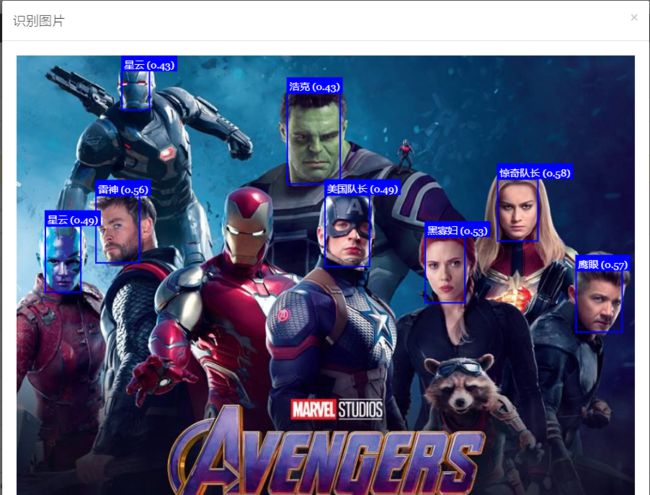功能
第一阶段实现对图片中人脸的识别并打上标签(比如:人名)
第二阶段使用摄像头实现对人物的识别,比如典型的应用做一个人脸考勤的系统
资源
- face-api.js https://github.com/justadudewhohacks/face-api.js/
Face-api.js 是一个 JavaScript API,是基于 tensorflow.js 核心 API 的人脸检测和人脸识别的浏览器实现。它实现了一系列的卷积神经网络(CNN),针对网络和移动设备进行了优化。非常牛逼,简单好用
- filepond https://github.com/pqina/filepond
是一个 JavaScript 文件上传库。可以拖入上传文件,并且会对图像进行优化以加快上传速度。让用户体验到出色、进度可见、如丝般顺畅的用户体验。确实很酷的一款上传图片的开源产品
- fancyBox https://fancyapps.com/fancybox/3/
是一个 JavaScript 库,它以优雅的方式展示图片,视频和一些 html 内容。它包含你所期望的一切特性 —— 支持触屏,响应式和高度自定义
设计思路
- 准备一个人脸数据库,上传照片,并打上标签(人名),最好但是单张脸的照片,测试的时候可以同时对一张照片上的多个人物进行识别
- 提取人脸数据库中的照片和标签进行量化处理,转化成一堆数字,这样就可以进行比较匹配
- 使用一张照片来测试一下匹配程度
最终的效果
Demo http://221.224.21.30:2020/FaceLibs/Index 密码:123456
注意:红框中的火箭浣熊,钢铁侠,战争机器没有正确的识别,虽然可以通过调整一些参数可以识别出来,但还是其它的问题,应该是训练的模型中缺少对带面具的和动漫人物的人脸数据。
实现过程
还是先来看看代码吧,做这类开发,并没有想象中的那么难,因为难的核心别人都已经帮你实现了,所以和普通的程序开发没有什么不同,熟练掌握这些api的方法和功能就可以做出非常实用并且非常酷炫的产品。
1、准备素材
下载每个人物的图片进行分类
2、上传服务器数据库
3、测试
代码解析
这里对face-api.js类库代码做一下简单的说明
function dodetectpic() { $.messager.progress(); //加载训练好的模型(weight,bias) Promise.all([ faceapi.nets.faceRecognitionNet.loadFromUri('https://raw.githubusercontent.com/justadudewhohacks/face-api.js/master/weights'), faceapi.nets.faceLandmark68Net.loadFromUri('https://raw.githubusercontent.com/justadudewhohacks/face-api.js/master/weights'), faceapi.nets.faceLandmark68TinyNet.loadFromUri('https://raw.githubusercontent.com/justadudewhohacks/face-api.js/master/weights'), faceapi.nets.ssdMobilenetv1.loadFromUri('https://raw.githubusercontent.com/justadudewhohacks/face-api.js/master/weights'), faceapi.nets.tinyFaceDetector.loadFromUri('https://raw.githubusercontent.com/justadudewhohacks/face-api.js/master/weights'), faceapi.nets.mtcnn.loadFromUri('https://raw.githubusercontent.com/justadudewhohacks/face-api.js/master/weights'), //faceapi.nets.tinyYolov.loadFromUri('https://raw.githubusercontent.com/justadudewhohacks/face-api.js/master/weights') ]).then(async () => { //在原来图片容器中添加一层用于显示识别的蓝色框框 const container = document.createElement('div') container.style.position = 'relative' $('#picmodal').prepend(container) //先加载维护好的人脸数据(人脸的特征数据和标签,用于后面的比对) const labeledFaceDescriptors = await loadLabeledImages() //比对人脸特征数据 const faceMatcher = new faceapi.FaceMatcher(labeledFaceDescriptors, 0.6) //获取输入图片 let image = document.getElementById('testpic') //根据图片大小创建一个图层,用于显示方框 let canvas = faceapi.createCanvasFromMedia(image) //console.log(canvas); container.prepend(canvas) const displaySize = { width: image.width, height: image.height } faceapi.matchDimensions(canvas, displaySize) //设置需要使用什么算法和参数进行扫描识别图片的人脸特征 const options = new faceapi.SsdMobilenetv1Options({ minConfidence: 0.38 }) //const options = new faceapi.TinyFaceDetectorOptions() //const options = new faceapi.MtcnnOptions() //开始获取图片中每一张人脸的特征数据 const detections = await faceapi.detectAllFaces(image, options).withFaceLandmarks().withFaceDescriptors() //根据人脸轮廓的大小,调整方框的大小 const resizedDetections = faceapi.resizeResults(detections, displaySize) //开始和事先准备的标签库比对,找出最符合的那个标签 const results = resizedDetections.map(d => faceMatcher.findBestMatch(d.descriptor)) console.log(results) results.forEach((result, i) => { //显示比对的结果 const box = resizedDetections[i].detection.box const drawBox = new faceapi.draw.DrawBox(box, { label: result.toString() }) drawBox.draw(canvas) console.log(box, drawBox) }) $.messager.progress('close'); }) } //读取人脸标签数据 async function loadLabeledImages() { //获取人脸图片数据,包含:图片+标签 const data = await $.get('/FaceLibs/GetImgData'); //对图片按标签进行分类 const labels = [...new Set(data.map(item => item.Label))] console.log(labels); return Promise.all( labels.map(async label => { const descriptions = [] const imgs = data.filter(item => item.Label == label); for (let i = 0; i < imgs.length; i++) { const item = imgs[i]; const img = await faceapi.fetchImage(`${item.ImgUrl}`) //console.log(item.ImgUrl, img); //const detections = await faceapi.detectSingleFace(img).withFaceLandmarks().withFaceDescriptor() //识别人脸的初始化参数 const options = new faceapi.SsdMobilenetv1Options({ minConfidence:0.38}) //const options = new faceapi.TinyFaceDetectorOptions() //const options = new faceapi.MtcnnOptions() //扫描图片中人脸的轮廓数据 const detections = await faceapi.detectSingleFace(img, options).withFaceLandmarks().withFaceDescriptor() console.log(detections); if (detections) { descriptions.push(detections.descriptor) } else { console.warn('Unrecognizable face') } } console.log(label, descriptions); return new faceapi.LabeledFaceDescriptors(label, descriptions) }) ) }
face-api 类库介绍
face-api 有几个非常重要的方法下面说明一下都是来自 https://github.com/justadudewhohacks/face-api.js/ 的介绍
在使用这些方法前必须先加载训练好的模型,这里并不需要自己照片进行训练了,face-api.js应该是在tensorflow.js上改的所以这些训练好的模型应该和python版的tensorflow都是通用的,所有可用的模型都在https://github.com/justadudewhohacks/face-api.js/tree/master/weights 可以找到
//加载训练好的模型(weight,bias) // ageGenderNet 识别性别和年龄 // faceExpressionNet 识别表情,开心,沮丧,普通 // faceLandmark68Net 识别脸部特征用于mobilenet算法 // faceLandmark68TinyNet 识别脸部特征用于tiny算法 // faceRecognitionNet 识别人脸 // ssdMobilenetv1 google开源AI算法除库包含分类和线性回归 // tinyFaceDetector 比Google的mobilenet更轻量级,速度更快一点 // mtcnn 多任务CNN算法,一开浏览器就卡死 // tinyYolov2 识别身体轮廓的算法,不知道怎么用 Promise.all([ faceapi.nets.faceRecognitionNet.loadFromUri('https://raw.githubusercontent.com/justadudewhohacks/face-api.js/master/weights'), faceapi.nets.faceLandmark68Net.loadFromUri('https://raw.githubusercontent.com/justadudewhohacks/face-api.js/master/weights'), faceapi.nets.faceLandmark68TinyNet.loadFromUri('https://raw.githubusercontent.com/justadudewhohacks/face-api.js/master/weights'), faceapi.nets.ssdMobilenetv1.loadFromUri('https://raw.githubusercontent.com/justadudewhohacks/face-api.js/master/weights'), faceapi.nets.tinyFaceDetector.loadFromUri('https://raw.githubusercontent.com/justadudewhohacks/face-api.js/master/weights'), faceapi.nets.mtcnn.loadFromUri('https://raw.githubusercontent.com/justadudewhohacks/face-api.js/master/weights'), //faceapi.nets.tinyYolov.loadFromUri('https://raw.githubusercontent.com/justadudewhohacks/face-api.js/master/weights') ]).then(async () => {})
非常重要参数设置,在优化识别性能和比对的正确性上很有帮助,就是需要慢慢的微调。
SsdMobilenetv1Options export interface ISsdMobilenetv1Options { // minimum confidence threshold // default: 0.5 minConfidence?: number // maximum number of faces to return // default: 100 maxResults?: number } // example const options = new faceapi.SsdMobilenetv1Options({ minConfidence: 0.8 }) TinyFaceDetectorOptions export interface ITinyFaceDetectorOptions { // size at which image is processed, the smaller the faster, // but less precise in detecting smaller faces, must be divisible // by 32, common sizes are 128, 160, 224, 320, 416, 512, 608, // for face tracking via webcam I would recommend using smaller sizes, // e.g. 128, 160, for detecting smaller faces use larger sizes, e.g. 512, 608 // default: 416 inputSize?: number // minimum confidence threshold // default: 0.5 scoreThreshold?: number } // example const options = new faceapi.TinyFaceDetectorOptions({ inputSize: 320 }) MtcnnOptions export interface IMtcnnOptions { // minimum face size to expect, the higher the faster processing will be, // but smaller faces won't be detected // default: 20 minFaceSize?: number // the score threshold values used to filter the bounding // boxes of stage 1, 2 and 3 // default: [0.6, 0.7, 0.7] scoreThresholds?: number[] // scale factor used to calculate the scale steps of the image // pyramid used in stage 1 // default: 0.709 scaleFactor?: number // number of scaled versions of the input image passed through the CNN // of the first stage, lower numbers will result in lower inference time, // but will also be less accurate // default: 10 maxNumScales?: number // instead of specifying scaleFactor and maxNumScales you can also // set the scaleSteps manually scaleSteps?: number[] } // example const options = new faceapi.MtcnnOptions({ minFaceSize: 100, scaleFactor: 0.8 })
最常用的图片识别方法,想要识别什么就调用相应的方法就好了
// all faces await faceapi.detectAllFaces(input) await faceapi.detectAllFaces(input).withFaceExpressions() await faceapi.detectAllFaces(input).withFaceLandmarks() await faceapi.detectAllFaces(input).withFaceLandmarks().withFaceExpressions() await faceapi.detectAllFaces(input).withFaceLandmarks().withFaceExpressions().withFaceDescriptors() await faceapi.detectAllFaces(input).withFaceLandmarks().withAgeAndGender().withFaceDescriptors() await faceapi.detectAllFaces(input).withFaceLandmarks().withFaceExpressions().withAgeAndGender().withFaceDescriptors() // single face await faceapi.detectSingleFace(input) await faceapi.detectSingleFace(input).withFaceExpressions() await faceapi.detectSingleFace(input).withFaceLandmarks() await faceapi.detectSingleFace(input).withFaceLandmarks().withFaceExpressions() await faceapi.detectSingleFace(input).withFaceLandmarks().withFaceExpressions().withFaceDescriptor() await faceapi.detectSingleFace(input).withFaceLandmarks().withAgeAndGender().withFaceDescriptor() await faceapi.detectSingleFace(input).withFaceLandmarks().withFaceExpressions().withAgeAndGender().withFaceDescriptor()
学习AI资源
ml5js.org https://ml5js.org/ 这里有很多封装好的详细的例子,非常好。
接下来我准备第二部分功能,通过摄像头快速识别人脸,做一个人脸考勤的应用。应该剩下的工作也不多了,只要接上摄像头就可以了


